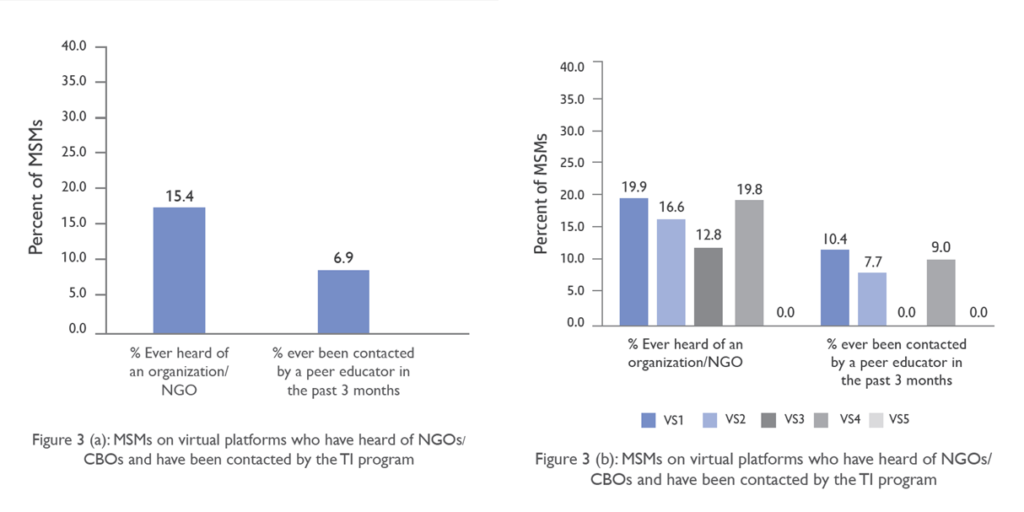

Accelerated advances of the digital age and Information Technology have led to the widespread popularisation of smartphones and spawned massive growth in the use of virtual platforms across every domain of modern society. Side by side, a shifting paradigm of solicitation behaviour has been observed among Men who have Sex with Men (MSM) in the National Capital Territory of Delhi (Delhi NCT) with their growing usage of these virtual platforms to contact/meet/get in touch with other MSMs as sexual partners. This evolution in practice presents wide-ranging policy and programmatic implications for the prevention, treatment and control of HIV.
This is a brief report that shares key evidence from a mapping and size estimation effort that has generated new estimates that reveal how a significant number of MSMs in the Delhi NCT are on multiple virtual platforms. It is also notable that not many of them have been contacted by conventional Targeted Interventions. This clearly establishes the need and opportunity for a specially-designed virtual intervention that can reach out to these communities to ensure that they have access to HIV prevention, treatment and control services.
The conventional Targeted Intervention (TI) program is a critical pillar of the overall response to HIV and AIDS in India, designed to reach Key Populations (KPs) through physical locations/hotspots. While this has been a highly effective approach, it was not designed to include and reach out to KPs (Men who have Sex with Men [MSMs] in this particular exercise), who operate through the increasingly popular digital space, specifically virtual platforms. This size estimation exercise was designed by the Delhi State AIDS Control Society (DSACS), in collaboration with its Technical Support Unit (TSU) – India Health Action Trust (IHAT), to address this gap and gather evidence as required to reach out to MSMs who are on virtual sites and largely unreached by the TI programs.
With modern societal trends shaped significantly by digital media and new communication, it is critical to design and deliver novel research and evidence related to the use of these technologies. This is particularly important when it comes to sexual solicitation by KPs through virtual networks and platforms, and the impact of these newer patterns on the HIV response in India. In addressing the needs of Delhi’s MSM population, it is important to note that although HIV prevalence among MSM in the city has declined over the years – from 5.34% in 2010 -11 to 1.80% in 2017 – current levels are still much higher than overall adult prevalence (0.30%)1. These figures point to a continuing need to reach MSMs with interventional support. The National AIDS Control Program reaches out to 16,052 MSMs through 11 TI programs in Delhi to provide HIV prevention, care and treatment services.
Solicitation patterns and behaviours are shifting, with the internet and smart phones changing the way partners are sought. Large numbers of MSMs have been shifting to virtual platforms. Current population size estimation methods are mapping those MSMs who are actively soliciting only in physical locations, while more and more people have already shifted to virtual spaces. This has significant implications for HIV programming, presenting a challenge that must be responded to if all KPs are to be reached.
Acknowledging this need, a virtual mapping exercise2 was taken up to initiate evidence-gathering that could become the foundation for designing a virtual intervention for MSMs. Since one of the inherent complexities in the overall HIV and AIDS response is getting accurate estimates of the target population for an intervention, the contextual relevance of undertaking a virtual mapping exercise of all MSMs who operate within the virtual space in Delhi was clearly understood and appreciated. It would be the first step towards designing effective outreach interventions for the group. The relevance of this effort is grounded in the idea that sound evidence about the size and characteristics of MSMs operating through virtual platforms and their exposure to programs is critical for HIV prevention programs.
This mapping and size estimation exercise was designed to identify and estimate the number of MSMs using mobile and web-based technology applications for social and sexual networking (virtual mapping) in Delhi. These networking operations are occurring through various virtual platforms – dedicated websites, social networking sites, social media pages and messenger applications – where MSMs are actively seeking partners.
The virtual mapping exercise was undertaken in all the 11 districts of the Delhi NCT. Inclusion criteria were all MSMs operating through virtual platforms and aged 18 years or above and acknowledging having exchanged sex in return for material or cash and agreeing to participate in the mapping process by giving their informed consent.
A team of community members with extensive knowledge of virtual sites and using virtual platforms were trained and mentored as Virtual Mappers (VMs). VMs were trained on mapping processes, tools, interview techniques, ethics and completeness of data. Through intensive discussions/consultations with community members active on virtual platforms, VMs collected information on names, types and features of the virtual sites. A comprehensive list of the various virtual platforms used by the MSM was developed. The VMs also conducted a review of the popularity of various virtual sites (mobile social apps and online websites) through community discussions. Further to this, popular sites were revisited to understand and examine the characteristics of active users and determine the feasibility of using virtual sites for mapping. The feasibility assessment was conducted using three criteria: (i) MSM-specific sites, (ii) Availability of information on active and online users, and, (iii) an identifiable geo location. After the assessment, five virtual sites were considered to be feasible for mapping. VMs created their own accounts and logged into the selected virtual sites with the purpose of enumerating active and online users on each site.
The respondent universe for the exercise was 565 MSMs who were interviewed face-to-face or online by the VMs across 16 different mapping locations in Delhi. This number was arrived at after a random selection of 128 MSMs from each of the five virtual sites identified for the exercise who were online at the time of mapping (a total of 640 individuals). Interviews could be conducted with 565 of them. Information was collected on the usage of virtual platforms for solicitation, presence on multiple virtual sites, characteristics and exposure to the TI program. Data collected were entered into a database developed for the size estimation and cross-checked at every level by the monitoring team. All data were analysed using Excel and SPSS Version 25.0. In order to maintain confidentiality, we have abstained from mentioning names of the virtual sites used by the MSM community.
Virtual sites are popular meeting places for a significant number of the MSMs in Delhi. Around 26,000 to 30,000 MSMs are using virtual sites to find other MSMs/partners and more than two-thirds are more active during the night and on Sundays.
A total of 28,058 MSMs are using virtual sites to find other MSMs/partners. The usage of virtual sites by time and day was also analysed, providing the insight that the majority of users preferred to be active during night-time (81%) and on Sundays (94%). About half of all MSMs mapped in the size estimation are using more than one virtual platform for solicitation (Figure 1).
A significant number of MSMs in Delhi use virtual sites to meet other sexual partners. A total of 14 MSM-specific virtual sites, 14 general virtual sites, 19 social networking pages exclusive for MSM and 112 messenger groups were listed in Delhi by VMs.

A higher number of MSMs active on virtual sites identified themselves as “Panthi” (insertive partners who prefer to be on top).
A large proportion of MSM in virtual sites are “Panthi”3 and double decker3. Thirty percent of the MSMs identify themselves as “Panthi” (those who prefer to be on top), 26% as “double decker” and 20% as bisexuals (Figure 2).

Just about two-fifths of the MSMs interviewed visited a physical location for solicitation in the month prior to the size estimation.
Two-fifths (42%) of the MSMs in Delhi visited any physical location for solicitation in the month prior to the size estimation. Considering the present program’s focus on hotspots, all or a large proportion of MSMs do not visit the hotspots and might not have been reached by the program.
Only 15% have heard about NGOs/ organisations providing HIV prevention and treatment services, and out of these, only 7% have been contacted by peer educators in the last three months before the size estimation. This indicates that the TI program with its physical hotspot-based mapping approach might be missing out on covering this virtually active population [Figure 3 (a & b)].

Information that can be critical for the development of effective HIV prevention strategies or for enhancing the efficacy of current program interventions has been gathered through this exercise. Important information about virtually-active MSMs, including population size estimates and several other visitation and solicitation characteristics has been gathered for the first time in Delhi through this size estimation.
It is evident that the conventional TI approach of intensive focus solely on physical hotspots does not reach all MSMs. This size estimation has shown how a significant number of MSMs are active through virtual sites and only two-fifths visit physical hotspots. Since reaching all KPs is critical to program effectiveness, size estimations that do not include virtual platforms may lead to under-estimation of the MSM population in the state and thereby lead to lower target-setting.
Understanding the patterns of virtual solicitation and the way the sites are being used is very important. For instance, usage patterns seem to vary with time and day, there is greater activity during the night, and on Sundays. Further, a majority of the population was found to be active on VS 3, VS 2 and VS 1. These are important aspects related to the population, its availability and solicitation patterns, and can aid more effective planning of outreach activities.
The MSM population in Delhi that is primarily active on virtual platforms seems to have very low awareness about organizations working on HIV. Exposure to current TI programs is quite low among these groups and this signals a clear program gap that must be bridged.
The findings from this size estimation and the new size estimates can be used to improve planning and target-setting for KP interventions, and more importantly, help to ensure effective service coverage to all MSMs operating through virtual platforms. This virtual mapping can become the foundation for an exhaustive virtual intervention to strengthen outreach to MSMs in Delhi NCT through the DSACS program under National AIDS Control Program. It is quite clear that TI programs must redesign their approach in order to include the large numbers of MSMs who are not within the ambit of the current, physical intervention.
1HIV Sentinel Surveillance 2017, NACO
3Panthi is the masculine insertive male partner or anyone who is masculine and seems to be a potential sexual (insertive) partner. Double Decker is the male who both insert and receive during penetrative sexual encounters (anal or oral sex). Targeted Interventions under NACP III: Operational Guidelines